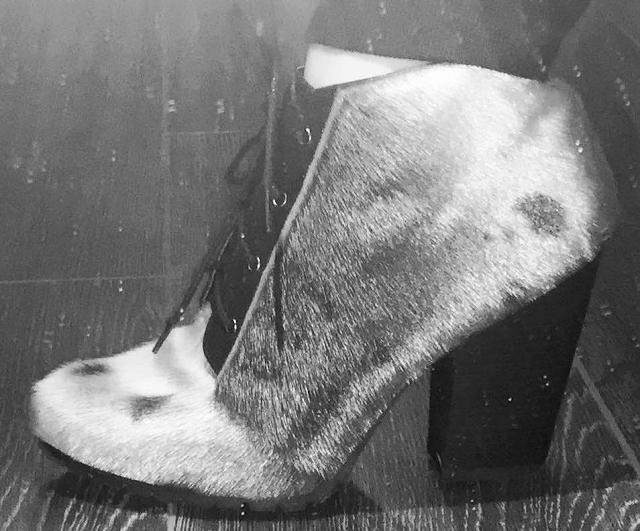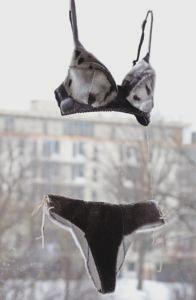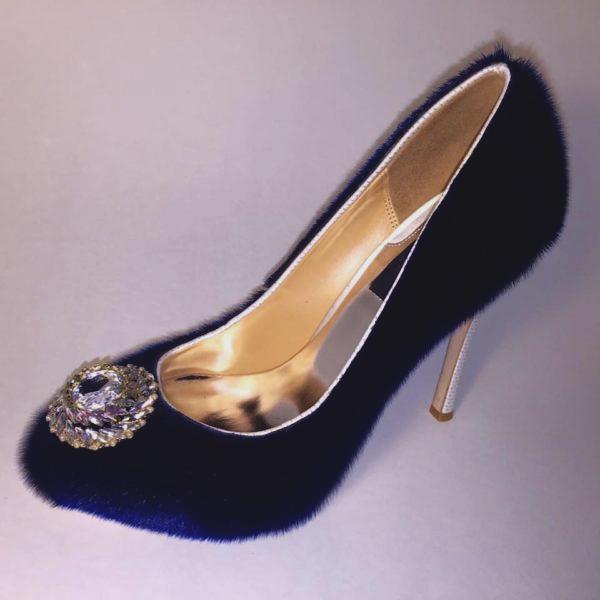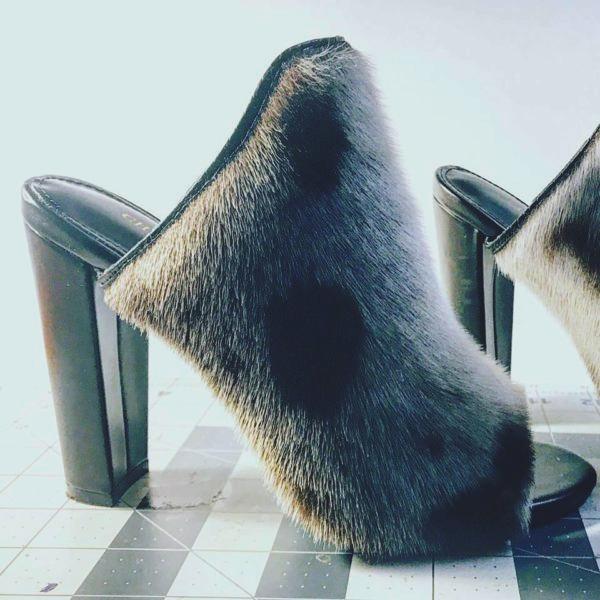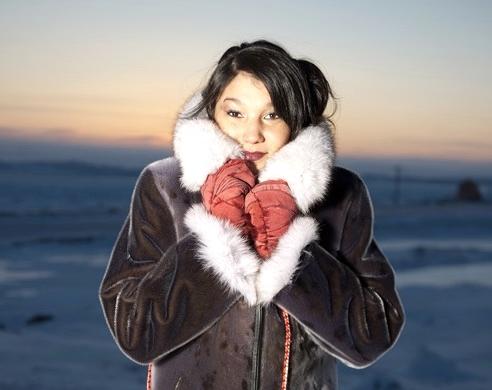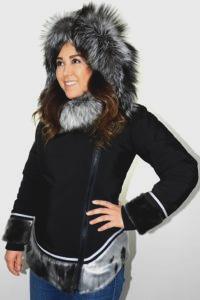 |
Canku Ota
|
 |
|
(Many Paths)
|
||
|
An Online Newsletter
Celebrating Native America
|
||
|
June 2017 - Volume 15
Number 6
|
||
|
|
||
|
Inuit Designers Revive
Sealskin Fashion, Celebrate 'National Seal Products Day,' May 20
|
||
|
by ICMN Staff
|
||
|
Today's sealskin
fashion fuses Inuit tradition with modern style —
in parkas, heels and lingerie
Sealskin fashion has claimed its place in haute couture. Once simply an essential winter wardrobe material in the icy cold of Northern Canada, today Inuit designers are expressing their cultural pride and creativity through less traditional means: high-fashion parkas, stilettos and even lingerie. "It's part of my culture," Victoria Kakuktinniq, founder of Victoria's Arctic Fashion, told The Guardian. "The Inuit are really trying our best to promote our culture and show our way of life and how our ancestors lived." Three Inuit designers are making major waves in the fashion world with their sealskin designs: Nala Peter, Nicole Camphaug and Victoria Kakuktinniq.
Peter sews lingerie of sealskin fur: bras, corsets, tank tops and panties. Like many local seamstresses, she put her Inuit fashion online. She turned to Facebook to promote her designs, and her bra quickly fetched $150. She eventually caught the eye of the art world and gained notoriety at an art exhibit in Ottawa: Floe Edge: Contemporary Art and Collaborations from Nunavut, reported CBC. Nicole Camphaug, ENB Artisan That art exhibit also featured the six-inch high heels designed by Nicole Camphaug, Inuk. Camphaug layers sealskin on shoes of all kinds, turning heads on the runway. In March 2012, she began promoting her side business, run out of her Iqaluit home, on Facebook: ENB Artisan. "I always think it's so important to get sealskin out there," Camphaug told The Guardian. Camphaug's passion for sealskin footwear extends into furry ballet flats, kitten heels and stilettos, reported CBC. Her designs became so popular that Camphaug enlisted her husband to help add fur to shoes. At ENB Artisan on Facebook, people can order designs in stock, or request a custom order by sending Camphaug shoes that she can cover in sealskin fur—with the option to dye it, too. Victoria Kakuktinniq, Victoria's Arctic Fashion (V.A.F.) Victoria Kakuktinniq, 27, honed her contemporary eye in the south, training in fashion design before returning home to Nunavut. She launched Victoria's Arctic Fashion (V.A.F.) in 2013, creating traditional northern garments and accessories with a fresh twist—namely stunning parkas, blazers, mitts and headbands.
At the recent Toonik Tyme festival in Iqaluit, Nunavut—featuring events like snowmobile drag races, igloo building, a dog team race on the sea ice, and a seal skinning competition—local designers sold a wide variety of sealskin items, , reported Nunatsiaq Online. White sealskin mittens by Emily Akavak-Hanson. Headbands and parkas from Victoria's Arctic Fashion. Ulus of varying sizes and shapes by Mosesie Lewis.
National Seal Products Day & Angry Inuk Today, Saturday, May 20, Canada celebrates its first ever National Seal Products Day. "Part of cultural references and ceremonies is the ability to partake in commerce for products, particularly with respect to fur," Newfoundland MP Scott Simms, who sponsored the bill, told CBC Radio-Canada. The day of celebration is also Canada's way of offering an olive branch to the Inuit community so vilified for decades due to the anti-seal movement that often implied Inuit were hunting endangered seal populations—which was never the case. Seal meat sustains Inuit communities, and sealskin has long served to protect Inuit from severe winter elements. Harvested by Inuit hunters and crafted by indigenous seamstresses, the seal hunt and seal fashion provide Inuit with a stable source of food and a reliable income. Inuit use the whole mammal—even the bone is purposed into buttons and clasps, according to sealingnunavut.ca, Nunavut's website promoting sustainable sealing.
Fierce opposition to seal hunting mounted in 1960s and '70s with graphic animal rights campaigns showing hunters bludgeoning baby seals. That gathered momentum, celebrities joining the crusade, and the European Union and U.S. eventually banned all seal imports. "I felt like something had to be said on the international stage about how unfairly we've been treated by anti-sealers. I had to make this film," Alethea Arnaquq-Baril, who created the documentary Angry Inuk, told CBC last year. As Arnaquq-Baril explained to CBC, when the European Union banned seal products from white coat baby harp seals in 1983, Inuit incomes dropped to about five per cent of what they were before the ban. "Inuit went hungry, had to move off the land and into town," she said. Then in 2009, the EU passed an even stricter ban on seal fur, and pelt prices collapsed. In 2015, the government of Nunavut negotiated an exemption from the EU ban that permits imports of sealskin wares certified as harvested by indigenous peoples. Despite the exemption, due to grossly inaccurate portrayals, the market for sealskin was practically dried up. Arnaquq-Baril's documentary, released in 2016, delves into the bans, the silenced voices of the Inuit, and the gross misrepresentation of the sealskin trade by animal rights groups and others. "They tried to minimize the importance of Inuit on the sealskin market, but in fact most people who sell sealskins in the world are Inuit," Arnaquq-Baril told CBC. "I want the world to know that sealing is extremely important to us as a people for food and for sealskins; that there are thousands of Inuit in Canada and Greenland that sell sealskins and are part of the commercial sealskin market," Arnaquq-Baril added. Canada's approval of National Seal Products Day on May 20 lends vital support to Inuit commercial traders. In honor of Saturday's National Seal Products Day, Natan Obed, president of Inuit Tapiriit Kanatami, a nonprofit organization in Canada that represents over 60,000 Inuit, planned to attend several events in Ottawa this week promoting sustainable sealskin fashion, while enjoying and sharing seal meat. "We participate in the sealing economy, from all our communities, our hunters, our seamstresses, everyone who eats seal meat. Everyone is a part of that sealing economy," Obed told CBC. |
|||||||||||||
|
|
|
|
||
|
|
||
| Canku Ota is a free Newsletter celebrating Native America, its traditions and accomplishments . We do not provide subscriber or visitor names to anyone. Some articles presented in Canku Ota may contain copyright material. We have received appropriate permissions for republishing any articles. Material appearing here is distributed without profit or monetary gain to those who have expressed an interest. This is in accordance with Title 17 U.S.C. Section 107. | ||
|
Canku Ota is a copyright ©
2000 - 2017 of Vicki Williams Barry and Paul Barry.
|
||
 |
 |
|
|
The "Canku
Ota - A Newsletter Celebrating Native America" web site and
its design is the
|
||
|
Copyright ©
1999 - 2017 of Paul C. Barry.
|
||
|
All Rights Reserved.
|
||
